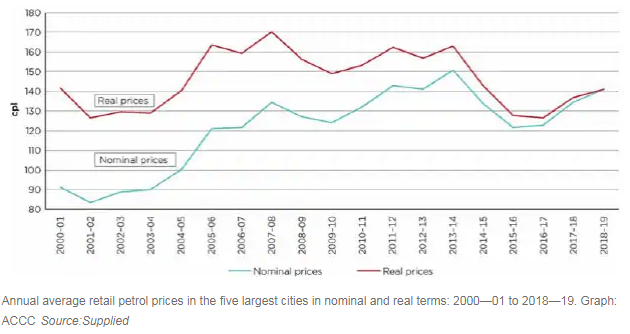Petrol prices have soared to the highest level in years but the consumer watchdog has tips to avoid the worst of it. Here’s how.
The weak Australian dollar has pushed petrol prices to their highest levels in four years.
The consumer watchdog says the main factor to the escalating cost has been the Aussie dollar weakening against its US counterpart because fuel is bought and sold in the latter’s currency.
The ACCC’s June quarter report on the petrol market shows the average annual price in the 2018/19 financial year in the five largest cities was 7.0 cents per litre higher than last year, now standing at 141.2 cents per litre.
“The most significant contributor to this increase was the depreciation over the year in the AUD-USD exchange rate, which decreased by USD 0.06 to USD 0.72,” said chair Rod Sims.
“This was the lowest annual average AUD-USD exchange rate in the last 15 years.
“The AUD-USD exchange rate is a significant determinant of Australia’s retail petrol prices because international refined petrol is bought and sold in US dollars in global markets.”
The watchdog said a significant development in the petrol industry in the first half of the year was the change in agreements at both Coles Express to Viva Energy and Woolworths to EG Group.
The report found that compared with market average prices, Coles Express prices were lower in most capital cities after Viva Energy began setting prices.
However, they remained above the market average price in all eight capital cities.
At Woolworths, prices were higher in most capital cities after EG Group took over the retail sites, although in the majority of cities, prices were still below the market average price.
Canberra recorded monthly average prices below the five largest cities — Sydney, Melbourne, Brisbane, Perth, Adelaide — for the first time since April 2012 which was likely caused by tighter regulation following an inquiry into the industry.
Westpac senior currency strategist Sean Callow said earlier this month he was predicting the RBA to leave the cash rate on hold again in September, but another cut will send the Aussie dollar spiralling further.
“We’ve got 66 (US) cents in the first half of next year, but if the RBA goes even earlier than we expected in rate cuts then it will be hard for the Aussie to avoid,” he said.
It might be reasonable to assume that petrol prices will continue to rise but Mr Sims told news.com.au the market fluctuations aren’t as simple.
The price of oil is linked to other commodity prices. And, commodity prices are typically what causes the Aussie dollar to move.
“It could well be that if the dollar is weak, that’s because commodity prices are weak,” Mr Sims said.
“So if the dollar goes down further, then you may get further reductions in the oil price.
“We don’t know what’s going to happen to petrol prices if the dollar goes down because we don’t know what’s going to happen to oil prices.
“(The) Australian petrol price is mainly a function of the exchange rate and the price of oil, and of course the price of oil has a lot to do with what OPEC (Organisation of the Petroleum Exporting Countries) tries to do.”
The ACCC tracks the fuel price cycle in every city, and a number of consumer apps are available to find the best deal near you, including the NRMA’s MyNRMA and RACWA’s RAC Go apps.
OTHER PETROL FAST FACTS FROM THE ACCC
• Brisbane petrol prices were higher than the other large Australian cities.
• The city to country petrol price differential decreased in the quarter to 1.5 cpl.
• Analysis of NSW’s Coffs Harbour petrol prices shows there are a range of prices available to motorists if they shop around.
• Diesel and automotive LPG prices in the five largest cities both increased.
Extracted from News.com.au
